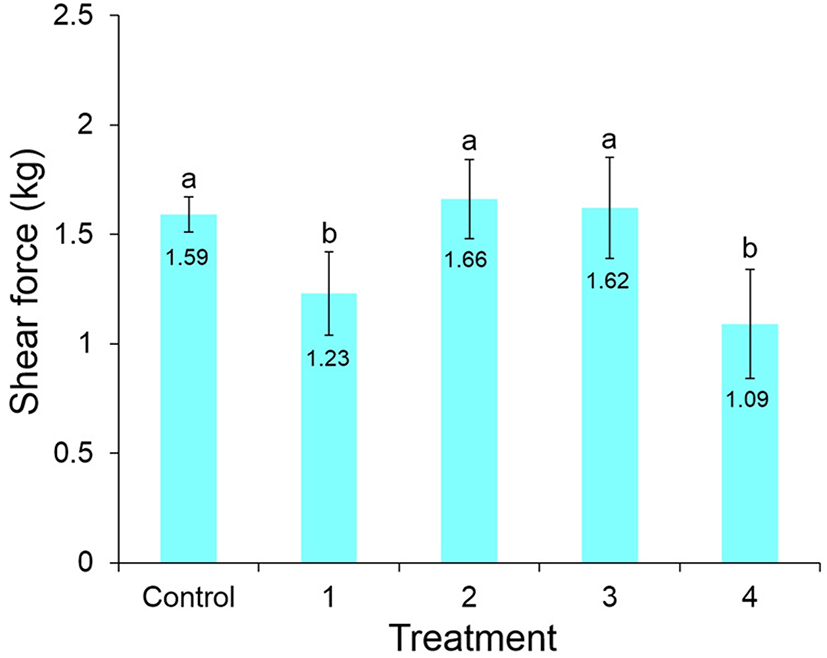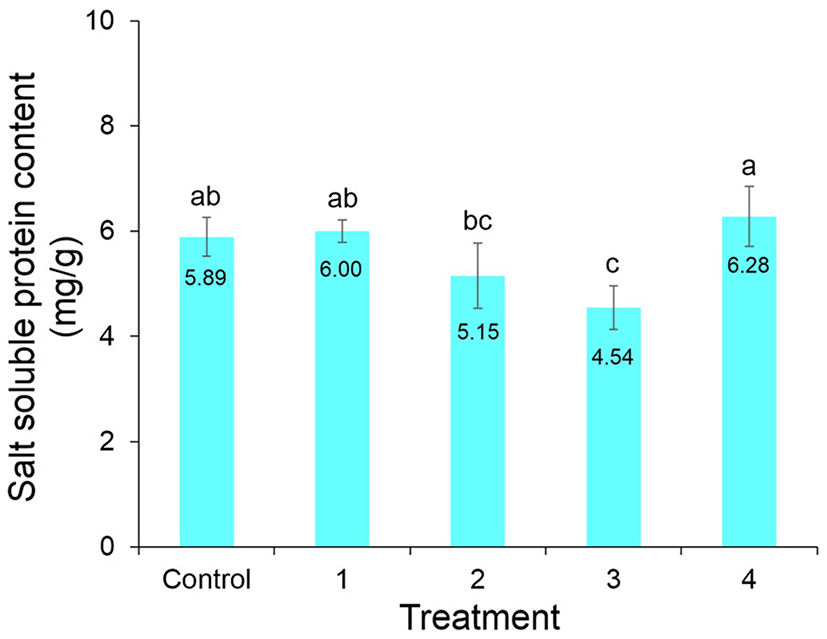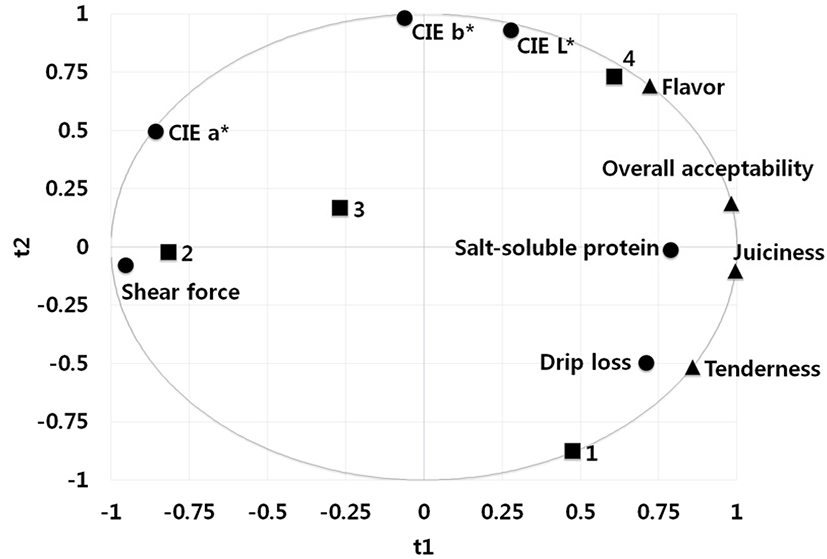Introduction
As a result of various social changes such as population aging and low fertility, increases in income levels, advancement of women into the work force, increases in single family households, and household nuclearization, there has been an increasing global trend in the use of cooked and semi-cooked foods (Byeon et al., 2015; Chung et al., 2007; Kim, 2013). Accordingly, the market size of home meal replacement (HMR) products in Korea has also been steadily growing with western style HMR foods such as cream soup, spaghetti, and hamburger steak, as well as with Korean style HMR foods such as beef rice bowl (beef deopbap), fried rice, and vegetable mixed rice (bibimbab) (Byeon et al., 2015). The main HMR products consumed in Korea are composed of rice, vegetables, and meat (Kim et al., 2015). Meat especially has been recognized as the most important component of HMR products as a protein source (Kim et al., 2015). The quality of the meat strongly depends on the cooking and freezing processes to which it is subjected. Meat is very sensitive to physical and chemical factors such as heating. In particular, heating is an important factor in the HMR production process. Depending on the heating method, physicochemical characteristics of meat such as fat content and moisture content can be changed, and physical factors including texture, shear force, chewiness, and sensory attributes are also affected (Kim et al., 2015; Mancini et al., 2005; Tornberg, 2005; Vasanthi et al., 2007).
Many studies have shown that physicochemical changes of the meat can occur depending on the cooking method, heating temperature, and cooking time used (Combes et al., 2003; Jeon et al., 2013; Kim et al., 2015). Various studies have also been carried out on the effects of freezing/thawing technologies on meat qualities. The effect of freezing/thawing on drip loss (Hansen et al., 2003; Linares et al., 2005; Xia et al., 2010), meat texture (Lagerstedt et al., 2008; Shanks et al., 2002; Vieira et al., 2009), and meat structure (Hansen, et al., 2003; Mortensen et al., 2006) have been reported.
There have been many studies on the effects of cooking and freeze-thaw processes on the quality changes of raw meat. Since most HMR products go through a freezing step after cooking, consumers must thaw the product before eating. Through the freezing and thawing processes, physicochemical properties of HMR products can be dramatically changed. However, only few studies on the effects of freeze-thaw processes on cooked meat have been carried out. In particular, only few studies on HMR products that have undergone freeze-thaw processes have been reported.
Therefore, this study aimed to investigate the quality characteristics of beef eye of round (ER) in HMR products that have undergone various cooking and freezing processes, and experimental analyses measured cooking and drip losses, water content, shear force, color, salt soluble protein, and conducted sensory testing.
Materials and Methods
Beef ER from Hanwoo steer (Korean native cattle; carcass weight, 386 kg; quality grade, 1+) was purchased from a local processor, and 50 g of ER (5 × 5 × 50 mm) was used for each treatment. Conditions of the four types of prepared treatments are presented in Table 1. For treatment 1, 3.0 g of canola oil (Beksul, Korea) was added to a pan (Special edition 24 cm, Tefal, France) and heated until the surface temperature of the pan reached to 190 ± 3°C. The temperature was read by an infrared thermometer (DT8380H, Sunche™, China) and was determined by preliminary experiments. Next, approximately 50 g of beef ER, 0.5% salt (Jeung Island solar salt, Korea), and 1.5% sugar (sucrose; Beksul, CJ Cheiljedang, Korea) were added to the pan and sautéed for 1 min. Commercial frozen rice (Hetbahn 210 g, CJ Cheiljedang, Korea) was thawed and heated in a microwave (600 W; KR-U150G, Daewoo, Korea) for 3 min, and double weights (100.4 ± 0.4 g) of rice against beef ER were weighed and mixed with the cooked beef in the bowl provided by the company for 2 min using chopsticks. The bowl was then sealed and stored at −50°C for 24 h in a conventional freezer (CRFD-0621, Samsung, Korea). The frozen sample was then thawed and heated in the microwave for 3 min, and the beef ER was separated carefully from the rice for the next step. For sample 2, all the procedures were the same as those for sample 1, with the exception of the addition of salt and sugar. For sample 3, all the procedures were the same as those for sample 1, except that the beef ER was not mixed with rice, but instead topped onto the rice. For sample 4, all the procedures were the same as those for sample 1, except the sample was cooled at room temperature (25°C) for 30 min before freezing.
This study was a comparison of the different types of processing of HMR products. Beef ER from HMR treatments 1 and 2 were used for each experiment. Since treatment 1 showed higher values of drip losses than treatment 2, the processing conditions for treatment 2 were applied to treatments 3 and 4. treatments 3 and 4 were then used for experimental comparison.
To determine the cooking loss of beef ER, samples were weighed before and after cooking, and cooking loss was calculated using the following equation:
To analyze drip loss of beef ER due to the freezing process, the weights of beef ER were measured before freezing and after thawing (Lee et al., 2015). The drip loss was calculated using the following equation, and the samples were repeated in triplicate for each condition.
Total loss was calculated using the weight of raw beef ER and the weight of thawed beef ER, and the calculation formula was as follows:
Shear force was evaluated using the method of Kim et al. (2015), and measured using a texture analyzer (CT3; Brookfield Co. Ltd., USA) with a stainless steel TA3 cutting type probe (length, 70 mm; width, 0.3 mm). The measurements were obtained using the following parameters: texture profile analysis (TPA) type, test speed = 2.5 m/s, trigger load = 300, force load cell = 10 kg, and target distance = 5 mm hardness. The maximum peak force (g) was used as the indicator of texture parameter. All these measurements were done in five replicates.
Color parameters of each beef ER sample were determined using CR-400 Chroma Meter (Konica Minolta Sensing, Japan) calibrated with a white standard plate (CIE L*=+96.79, CIE a*=+0.30, CIE b*=+1.67). Six pieces of beef ER were arranged lengthwise, and the surface color of the samples was measured 10 times. The resulting values are presented as lightness (CIE L*), redness (CIE a*), and yellowness (CIE b*). The total color difference (ΔE) was calculated using the color difference between the fresh beef ER and the treated samples as follows:
Salt-soluble proteins were extracted from beef ER according to the modified method of DeFreitas et al. (1997). Briefly, one part of thawed beef ER samples and three parts of isolation buffer (0.5 M NaCl, 17.8 mM Na5P3O10, pH 8.3) were homogenized in a blender (SMT PH 91, SMT, Japan) for 60 s at medium speed. The slurry was kept at 4°C for 2 h, followed by centrifugation (12,000 rpm) at 4°C for 60 min (1736R, Labogene, Korea). The extract was then filtered through several layers of cheesecloth. Protein concentrations of filtered supernatant were determined using the BCA Protein Assay reagent (Sigma-Aldrich, USA).
Sensory testing was conducted essentially according to the method of Cho et al. (2009) with minor modifications. Among the graduate students from the Department of Food Science and Biotechnology of Animal Resources, 15 students with training and experience on sensory test were selected for this test. To eliminate bias or prediction of the samples, each sample container was labeled with numbers selected from a random number table and sealed with lids to maintain the temperature (50 ± 1°C) and moisture of the beef ER sample. Tenderness, juiciness, flavor, and overall acceptability were evaluated by the line scale estimation method, which used a 100 mm long horizontal line for each criterion. Sensory evaluation was conducted for the following criteria: tenderness = extremely stringy (0), extremely tender (100); juiciness = extremely dry (0), extremely juicy (100); flavor = dislike extremely (0), like extremely (100); overall acceptability = dislike extremely (0), like extremely (100).
All analyses were carried out in at least 3 replicates. The resulting data are shown as the means with standard deviations and were analyzed by one-way analysis of variance (ANOVA) followed by Duncan’s multiple range test. Differences were considered significant at the level of p<0.05 using the software SPSS 22.0 (SPCC Inc., USA). Partial least squares regression (PLSR) were conducted using XLSTAT ver. 2016. 02. 28540 (Addinsoft, USA).
Results and Discussion
Cooking loss and drip loss of the beef ER samples are presented in Table 2. Cooking loss values were not found to be significantly different among the treatments. According to the results, the addition of salt and sugar did not significantly change cooking loss between treatment 1 and the other treatments, which did not have added salt and sugar. It is assumed that addition of salt and sugar to the beef during the sauté process (1 min) did not cause cooking loss from the beef ER. For the drip loss analysis, the samples before freezing and after thawing were weighed. There was no significant difference between treatments 1 and 2; however, treatments 3 and 4 presented significantly lower values of drip losses compared to treatments 1 and 2, which lost drip through the mixing process with rice, as expected. Total losses of treatments 3 and 4 were significantly lower than those of treatments 1 and 2, while treatments 1 and 2 did not show statistical significance. This appears to mainly be caused by the drip loss values of the beef ER samples, and the trend of total loss was similar to that of freeze-thawing drip loss.
a-cMeans with different superscripts in the same column are significantly different between treatments at p<0.05 by Duncan’s multiple range test.
Fig. 1 presents the change in the shear force of beef ER in HMR products prepared from different processes. Sautéed beef ER was used as a control and had a shear force of 1.59 kg. Compared with the control, treatments 1 and 4 showed significantly lower values, while treatments 2 and 3 had slightly higher values. No trend was observed between shear force values of beef ER samples with or without mixing with rice. The lowest value (1.09 kg) was from sample 4 which was precooled before freezing. Since the value of raw beef ER was 1.015 ± 0.17, shear forces of all samples did not appear to dramatically increase after the cooking, freezing, and thawing processes. Kim et al. (2015) reported that beef ER that was pan-fried for 1 min had a shear force value of 3.16 kg. They reported that the actual frying temperature of the oil was more than 190°C, even though their stated method was to fry at 190°C. However, in this study, the frying temperature was kept at 190 ± 3°C and was monitored by a DT8380H infrared thermometer (SuncheTM). Beef ER was also cross cut of muscle fibers to increase tenderness. This may have decreased the shear force values. Even though tenderness is important to maintain the quality of cooked beef in HMR products (Yang and Ko, 2010), it is imperative that all components in HMR products be fully cooked prior to packaging due to the ready-to-eat nature of these products. Since sautéed beef generally has a golden-brown, crispy surface, resulting in a high shear force (Shabbir et al., 2015), the sauté conditions and skill used in this study suggest that it was an acceptable sauté method, which was able to minimize the increase in shear force.

The color changes of the treated beef ER samples were compared with those of the control (Table 3). Sautéed beef ER was used as a control. All CIE L*, CIE a*, and CIE b* values of the treated beef ER samples were lower compared to the control (p>0.05 and p<0.05). This indicates that freezing and thawing processes lead to the discoloration of lightness, redness, and yellowness of beef ER in HMR products. In the lightness analysis, treatments 1 and 2 showed significantly lower CIE L* values than the control (p<0.05), while treatments 3 and 4 showed only slightly decreased values (p>0.05). The lightness of beef ER decreased through the mixing with rice. Redness discoloration was clearly observed in treatment 1. However, no trend was observed among the treated beef ER samples during different processes.
a-dMeans within the same column with different superscript letters are significantly different by Duncan’s multiple range test (p<0.05).
†Control is beef ER sautéed for 1 min.
Only beef ER treatments 1 (7.29 ± 0.83) showed a significantly different b* value from the control (9.08 ± 0.46). The yellowness values of all beef ER samples presented a similar pattern as for lightness. Treatments 1 and 2 showed lower values than treatments 3 and 4, indicating that the yellowness of beef ER decreased through the mixing with rice. It seems that starch released from the rice in the HMR product covered the beef ER, and this led to a decrease in redness and yellowness of the beef. A previous study was in agreement with our results. The effects of different starches (3 and 6% w/w) on the color of surimi-beef gels showed that all starches significantly decreased redness and yellowness (Zhang et al., 2013)
All values for total color difference (ΔE) of beef ER samples showed significant differences, and treatment 1 presented the highest value (8.30 ± 0.94) indicating that it had the most discoloration. In the total color difference analysis, beef ER samples mixed with rice (treatments 1 and 2) showed significantly higher values than those not mixed with rice (treatments 3 and 4). In particular, treatment 4 presented the lowest value (1.03 ± 0.63) compared to the control, which indicates that the color of this sample only slightly changed due to the freezing and thawing processes.
The effect of different processes on the salt soluble protein content of beef ER samples is shown in Fig. 2. Compared to the control (5.89 mg/g), only treatment 3 presented a significantly lower value (4.54 mg/g, p<0.05), while the values of the other treatments were only slightly reduced or increased (p>0.05). Unexpectedly, the value of treatment 1 was not deceased, even though salt was added to this sample. A short mixing process (during sautéing) for 1 min allowed salt to coat the sample. Afterwards, samples were quickly frozen to −50°C and held for 24 h before thawing with a microwave. It appears that the quick processing did not allow for the salt to react with protein in the sample. It is known that freezing can cause protein denaturation, resulting in the alteration of protein solubility (Lan, 1993). However, a clear trend was not observed in this study due to the limited seasoning process.

Sensory attributes of all beef ER samples in HMR products produced through various processes were investigated along with their physicochemical properties by PLSR analysis (Fig. 3). Tenderness in the sensory test was related to drip loss, and the closest relationship between these parameters was seen in treatment 1, in which salt and sugar were added during sautéing. It could be surmised that the texture of treatment 1, which had high drip loss, slightly deteriorated, and the panels interpreted this as increased tenderness. All sensory attributes including flavor, overall acceptability, juiciness, and tenderness were related, and they were relevant to drip loss, salt soluble protein, and CIE L*. However, all sensory attributes were least relevant to shear force, CIE a*, and beef ER sample 2. PLSR revealed that drip loss was highly related to tenderness. It can be assumed that panels perceived high tenderness from the beef ER samples that had highly deteriorated tissues. PLSR also unexpectedly showed that drip loss was related to juiciness. High drip loss of meat is not always proportional to juiciness. Through PLSR analysis, treatment 4 was concluded to be the most preferable for use in HMR products according to the panels and physicochemical analysis, since it was high in flavor and overall acceptability, and low in non-preferred shear force.

Conclusions
This work evaluated physiochemical properties and sensory attributes of beef ER in HMR products under various preparation processes. The results of the drip losses and total losses of beef ER samples 3 and 4 (without mixing with rice) were significantly lower than those of treatments 1 and 2, which were mixed with rice, while the cooking process (sauté) did not significantly differentiate any samples. Therefore, beef ER samples that are mixed with rice appear to be more affected by freezing and thawing processes than by the cooking process. Discoloration of treatment 4 (cooling before freezing) was less than for any other treatment, while treatment 1 was the most discolored by the processing. Even though beef ER samples were sautéed for 1 min, the shear force values were slightly increased in treatments 2 and 3 compared with the control and were significantly decreased in beef ER samples 1 and 4. Through PLSR analysis, treatment 4 was selected to be the most preferable to sensory panels and by physicochemical evaluation.













